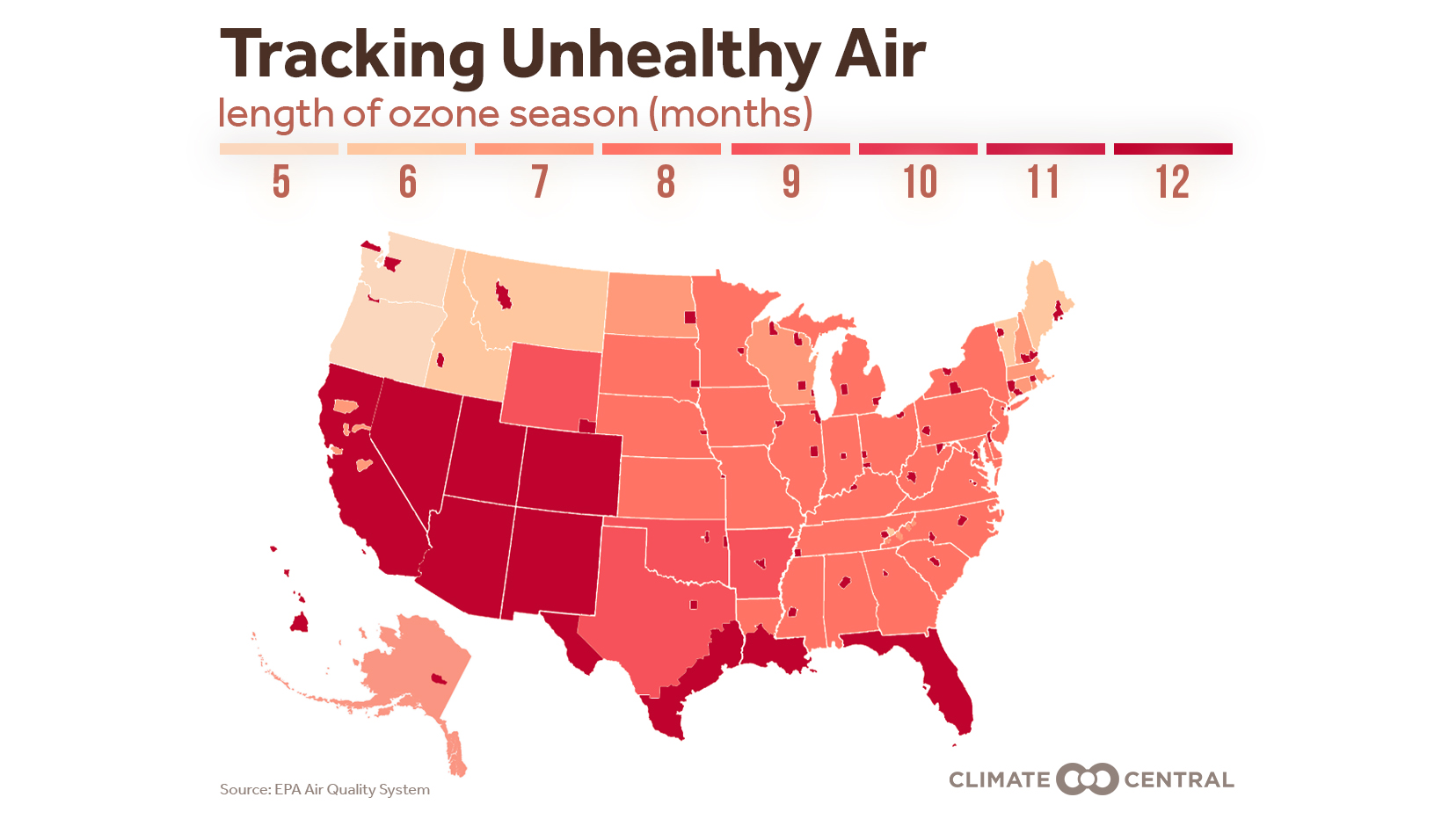As summers heat up, the air we breathe is increasingly at risk of becoming unhealthy, despite decades of air quality improvements.
KEY CONCEPTS
Stagnant air days are becoming more frequent, in part due to hotter summers.
A Climate Central analysis found the number of annual stagnant days has increased in 83% of the contiguous U.S. cities analyzed.
During a stagnation event, air pollutants such as ozone can get trapped, making it difficult to breathe, and potentially causing a multitude of health problems.
Climate Central identified 54 cities with an “ozone problem,” defined as experiencing numerous unhealthy ozone days or cities experiencing a recent increase in such days, potentially threatening long-term trends of air quality improvement.
“Ozone season,” the period when states and communities monitor local air quality for unhealthy levels of ozone, is now year-long in eight states and in dozens of urban areas across the country.
VIEW REPORTDOWNLOAD DATA
Unhealthy Ozone Days
WHAT YOU NEED TO KNOW
Stagnant Air
Stagnation occurs when an air mass remains stuck over a geographic area for an extended period of time.
Heat and stagnation are closely linked. Climate Central analyzed summer high temperatures and used data from NOAA/NCEI. Nearly all cities analyzed showed a positive correlation between summer maximum temperatures and the number of summer stagnant days.
Stagnation is happening more frequently.Our analysis showed McAllen, Texas tops the list with 36 more days per year on average, followed by Los Angeles and San Francisco (where stagnation is less correlated with heat). As the climate warms, stagnant days are projected to increase further.
Unhealthy Ozone
Ground-level ozone is produced when warm and sunny conditions spur the reaction of two pollutants (nitrogen oxides and volatile organic compounds) released from human sources like tailpipes, power plants, industrial facilities and farms and some natural sources.
Higher ozone levels mean unhealthier air, and the U.S. Environmental Protection Agency sets the standard that defines an “unhealthy ozone” days.
Climate Central analysis of EPA data from 2000 through 2018 covering 244 cities showed that air quality has been improving around the country, but a number of cities still face unhealthy ozone levels.
Forty cities experienced at least 20 unhealthy ozone days in total between 2015 and 2018, including four cities that had more than 300 high ozone days.
Another 14 cities had relatively fewer unhealthy days, but showed high ozone days ticking upward in recent years, such as New York City, Colorado Springs, and Oklahoma City.
Cities with the greatest annual average of unhealthy ozone days over the last four years were Palm Springs (113) and Los Angeles (99).
As the climate continues to warm, unhealthy ozone days are projected to worsen in some areas in the years ahead.
Even just a few unhealthy ozone days a year pose health concerns, as an increasing number of health risks are being linked to exposure to ozone and other air pollutants, including asthma, shortness of breath, developmental problems in children and reproductive harm in adults.
METHODOLOGY: Climate Central analyzed gridded stagnation data from the NOAA/NCEI Air Stagnation Index, annual average summer (June, July, and August) maximum temperature data obtained from the Applied Climate Information System, and dailyozone data from the EPA Air Quality System. The full methodology is spelled out in our report.
POTENTIAL STORY ANGLES
How are residents in your area being affected by poor air quality?
Local pulmonologists and allergists could explain how air pollution affects the health of residents in your region. The American Lung Association (media@lung.org) could help you identify some in your area and they produce an annual State of the Air report with city rankings for air pollution.
These doctors and your family, neighbors and colleagues could help you find local residents to interview who suffer from asthma and other lung diseases.
Sports coaches and workers at construction sites, parks and elsewhere could share their experiences of coping with air pollution and heat.
LOCAL INTERVIEW SUGGESTIONS
States have local environmental and health agencies (listed here by the U.S. EPA).
Association of Air Pollution Control Agencies is made up of staff from state and local agencies that monitor and regulate air quality.
AirNow partners https://airnow.gov/index.cfm?action=airnow.partnerslist
The SciLine service,500 Women Scientists or the press offices of local universities may be able to connect you with local climate scientists with expertise in heat and air quality.
